Soft Tissues: Clear cell sarcoma
2002-11-01 Bruce Poppe , Ramses Forsyth , Karl Dhaene , Frank Speleman Affiliation1.Center for Medical Genetics, Ghent University Hospital MRB, De Pintelaan 185, 9000 Ghent, Belgium
Summary
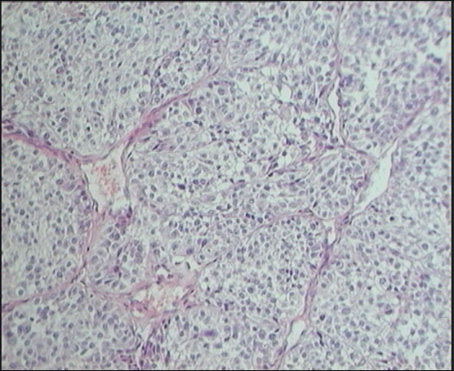
Nests of clear polygonal cells delineated by fibrous septa (H&E, 200x).
Clinics and Pathology
Note
To be distinguished from clear cell sarcoma of the kidney, to which it is unrelated.
Embryonic origin
mesoderm
Epidemiology
rare sarcoma affecting primarily young adults
Clinics
slowly growing tumour mass, causing pain or tenderness, particularly frequently (up to 95% of the cases) situated in the extremities, with a predilection for the foot and the ankle.
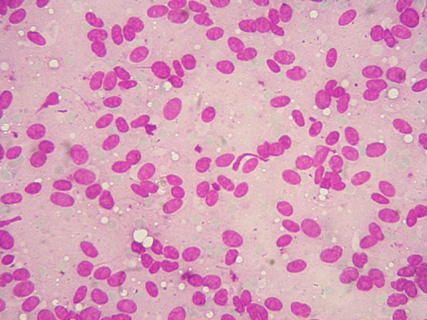
Cellular smear almost exclusively showing dispersed spindle cells. Their oval nuclei are only slightly irregular and contain a large nucleolus. The cytoplasm is rather scant (MGG, 400x) (Courtesy of Dr. J. Willems, Onze-Lieve-Vrouw Ziekenhuis Aalst, Belgium).
Pathology
Polygonal or spindle shaped cells with abundant eosinophilic or clear cytoplasm displaying a uniform, nested to fascicular growth pattern, delineated by fibrous septa. Melanin deposits can be demonstrated using specific stains, but is more readily detectable by immunoreactivity against melanoma antigens (e.g. S100 and HMB45) in the vast majority of the cases.

Left to right: A: Typical clear cell sarcoma with eosinophilic cytoplasm (H&E, 400x); B: A reticulin meshwork surrounds the individual nests (reticulin, 200x); C: Strong S100 immunoreactivity, a consistent feature (S100, 400x).
Treatment
radical surgical resection, adjuvant radiotherapy should be considered in incomplete resections, large (>5 cm) tumours and/or high grade lesions. Clear cell sarcomas seems to display little sensitivity to conventional soft tissue sarcoma multi-agent chemotherapy protocols.
Evolution
special attention should be paid to the occurrence of late recurrences (median time to recurrence: 4.2 years).
Prognosis
Generally, clear cell sarcoma is characterised by an adverse prognosis, only 40 to 50% of the patients being long-term survivors. As recurrences may occur late, 5-year survival rates tend to misjudge prognosis. Established prognostic features include: tumour size, necrosis and local recurrence.
Cytogenetics
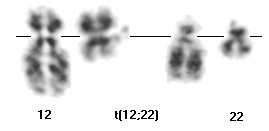
The t(12;22)(q13;q12), as identified by G-banding.
Cytogenetics morphological
The cytogenetic hallmark of clear cell sarcoma is the presence of the t(12;22)(q13;q12). This translocation has been described in the majority of reported clear cell sarcoma cases, not however in other malignancies. The translocation is readily identifiable with G-, R- or Q-banding.
Cytogenetics molecular
Fluorescence in situ hybridisation based approaches can be used to demonstrate the t(12;22), using chromosome painting probes or to demonstrate EWSR1 and ATF1 gene rearrangement, using gene specific probes.
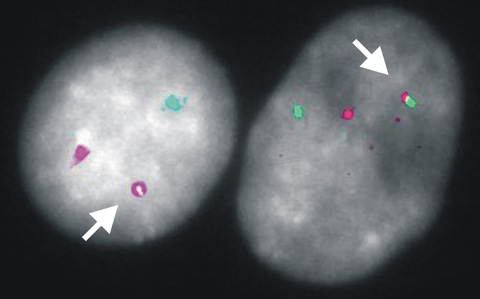
dual colour in situ hybridisation the EWS cosmid G9 (green) and the ATF1 CCS2.2 cosmid (red) demonstrating a juxtaposition of 5 EWS to 3 ATF1 sequences, indicating the presence of a EWS/ATF1 genomic fusion (arrowheads).
Probes
EWSR1 probes: 5 EWSR1: G9 cosmid; 3 ATF1 probe: CCS2.2
Additional anomalies
Although the t(12;22) has been reported as the sole chromosomal aberration in clear cell sarcoma, most cases display additional cytogenetic anomalies, including +7, +8 and structural and numerical aberrations of chromosome 22.
Variants
No variant translocations, creating EWSR1/ATF1 fusion transcripts, have been described.
Genes Involved and Proteins
Gene name
EWSR1 (Ewing sarcoma breakpoint region 1)
Location
22q12.2
Note
also called EWS.
Dna rna description
EWSR1 is transcribed from centromere to telomere at 22q12. The coding sequence contains 1971 bp, comprising 17 exons and spans approximately 32kb. Alternative splicing creates the EWS-b variant, lacking exons 8 and 9.
Protein description
The EWS protein contains a C-terminal RNA binding domain and has indeed been shown to display RNA binding properties. The functions of the EWS protein, however, largely remain elusive.
Gene name
ATF1 (activating transcription factor 1)
Location
12q13.12
Dna rna description
ATF1 is transcribed from centromere to telomere at 12q13. The coding sequence contains 816bp, comprising 6 exons and spans approximately 43kb.
Protein description
ATF1 encodes a member of the CREB/ATF basic leucine-zipper type transcription factor family and binds to cAMP inducible promotors.
Result of the chromosomal anomaly
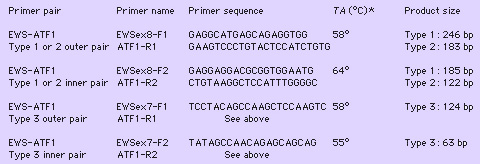
detection protocole: as described by Antonescu et al. (the data given are virtually identical to the Table 1 from the mentioned reference)
Description
The EWS/ATF1 fusion transcript is detectable in up to 90% of the clear cell sarcoma cases. As described in other EWS rearrangements, the transcript fuses 5 EWS to 3 heterologous sequences. The reciprocal ATF1/EWS fusion probably does not contribute to malignant transformation since it is out of frame.
Transcript
Several alternatively spliced transcripts have been described, the more frequent being the type 1 fusion: EWS exon 8 fused to ATF1 exon 4.
Oncogenesis
The EWS/ATF1 oncoprotein converts ATF1 to a constitutive transcriptional activator that represses p53/CBP-mediated transactivation.
Article Bibliography
Citation
Bruce Poppe ; Ramses Forsyth ; Karl Dhaene ; Frank Speleman
Soft Tissues: Clear cell sarcoma
Atlas Genet Cytogenet Oncol Haematol. 2002-11-01
Online version: http://atlasgeneticsoncology.org/solid-tumor/5074/soft-tissues-clear-cell-sarcoma
